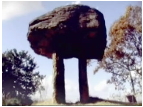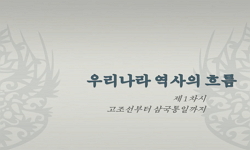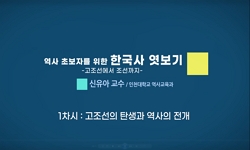As a way to understand social and cultural aspects of Old Chosun, this thesis examined several things about the sites of the dolmen and the stone-pile(돌돌림) where people at the time had performed the rituals. Though the materials reported are ve...
http://chineseinput.net/에서 pinyin(병음)방식으로 중국어를 변환할 수 있습니다.
변환된 중국어를 복사하여 사용하시면 됩니다.
- 中文 을 입력하시려면 zhongwen을 입력하시고 space를누르시면됩니다.
- 北京 을 입력하시려면 beijing을 입력하시고 space를 누르시면 됩니다.
부가정보
다국어 초록 (Multilingual Abstract)
Geographical conditions of dolmen and stone-pile sites where the rituals were held seem to be chosen intentionally to be an area with the wide open view easily seen from everywhere around.
The structural characteristic of dolmens associated with worshipping is, first that the cover stone(덮개돌) and supporting stones(굄돌) were mended a lot. The dolmens of Daeja and Sukboongsan were so neatly mended that they were well engaged. It's remarkable the cover stone outreaches the supporting stones, making eaves.
Daeja and Sukboongsan dolmens coexisting with the shrine(廟宇) or the temple in old times, became the object of worshipping. There in the stone chamber were wooden tablets(木主), an incense burner, ancestral tablets(神位), and earthen goods related with the rituals.
The construction method of almost all the stone-pile sites was confirmed to compart the land by putting the edge stones(둘레돌) first, and then fill their inside with random stones. The flat plank stone beside the edge stones is regarded as related to the ritual performance.
About the matter of the origin of stone-pile sites, considering their structural aspects, I compared them with Niuheliang's area 13 stone piles or area 2 number 3 altar and Dongshanzui ritual site which are connected with Hongshan culture. The stone-pile sites are searched together with dolmens and menhirs nearby, and interpreted as a symbol of mega-lithic culture.
As a way to understand social and cultural aspects of Old Chosun, this thesis examined several things about the sites of the dolmen and the stone-pile(돌돌림) where people at the time had performed the rituals. Though the materials reported are very restrictive, results inferred from various points of view are arranged as follows.
Geographical conditions of dolmen and stone-pile sites where the rituals were held seem to be chosen intentionally to be an area with the wide open view easily seen from everywhere around.
The structural characteristic of dolmens associated with worshipping is, first that the cover stone(덮개돌) and supporting stones(굄돌) were mended a lot. The dolmens of Daeja and Sukboongsan were so neatly mended that they were well engaged. It's remarkable the cover stone outreaches the supporting stones, making eaves.
Daeja and Sukboongsan dolmens coexisting with the shrine(廟宇) or the temple in old times, became the object of worshipping. There in the stone chamber were wooden tablets(木主), an incense burner, ancestral tablets(神位), and earthen goods related with the rituals.
The construction method of almost all the stone-pile sites was confirmed to compart the land by putting the edge stones(둘레돌) first, and then fill their inside with random stones. The flat plank stone beside the edge stones is regarded as related to the ritual performance.
About the matter of the origin of stone-pile sites, considering their structural aspects, I compared them with Niuheliang's area 13 stone piles or area 2 number 3 altar and Dongshanzui ritual site which are connected with Hongshan culture. The stone-pile sites are searched together with dolmens and menhirs nearby, and interpreted as a symbol of mega-lithic culture.
국문 초록 (Abstract)
의례 행위를 하였던 고인돌과 돌돌림 유적의 입지 조건은 어디에서나 쉽게 바라볼 수 있도록 주변이 훤히 틔어 있는 조망이 좋은 지역을 의도적으로 선택하였던 것 같다.
숭배와 관련된 고인돌의 구조적인 특징은 먼저 덮개돌과 굄돌을 많이 손질한 것이다. 대자나 석붕산 고인돌은 매끈하게 손질하였기에 서로 잘 맞물려 있다. 또 덮개돌이 굄돌 밖으로 나와 처마를 이루고 있는 점도 주목된다.
대자와 석봉산 고인돌은 옛날에 묘우나 절안에 같이 있으면서 숭배의 대상이 되었고 돌방 안에 제의와 관련 있는 목주· 향로· 신위, 토제품등이 놓여 있다.
돌돌림 유적의 축조방법은 거의가 먼저 둘레돌을 놓아 가장자리를 구획한 다음 그 안에 막돌을 채워 놓은 것으로 밝혀졌다. 그리고 둘레돌 옆에 있는 납작한 판자돌은 제의 행위와 관련 있는 것으로 여겨진다.
돌돌림 유적의 기원 문제는 구조적인 측면을 고려해 볼 때 홍산 문화와 관련된 우하량 13 지점 돌무지나 2 지점 3호 제단, 동산취의 제의 유적과 비교해 보았다. 돌돌림 유적은 주변에서 고인돌· 선돌과 함께 조사되어 거석문화의 한 표상으로 해석된다.
고조선의 사회상이나 문화상을 이해하기 위한 하나의 방안으로 당시 사람들이 제의를 행하였던 고인돌과 돌돌림 유적에 관한 몇 가지를 살펴보았다. 보고된 자료가 아주 제한적이지만 여러...
고조선의 사회상이나 문화상을 이해하기 위한 하나의 방안으로 당시 사람들이 제의를 행하였던 고인돌과 돌돌림 유적에 관한 몇 가지를 살펴보았다. 보고된 자료가 아주 제한적이지만 여러 관점에서 추론된 결과를 정리하면 다음과 같다.
의례 행위를 하였던 고인돌과 돌돌림 유적의 입지 조건은 어디에서나 쉽게 바라볼 수 있도록 주변이 훤히 틔어 있는 조망이 좋은 지역을 의도적으로 선택하였던 것 같다.
숭배와 관련된 고인돌의 구조적인 특징은 먼저 덮개돌과 굄돌을 많이 손질한 것이다. 대자나 석붕산 고인돌은 매끈하게 손질하였기에 서로 잘 맞물려 있다. 또 덮개돌이 굄돌 밖으로 나와 처마를 이루고 있는 점도 주목된다.
대자와 석봉산 고인돌은 옛날에 묘우나 절안에 같이 있으면서 숭배의 대상이 되었고 돌방 안에 제의와 관련 있는 목주· 향로· 신위, 토제품등이 놓여 있다.
돌돌림 유적의 축조방법은 거의가 먼저 둘레돌을 놓아 가장자리를 구획한 다음 그 안에 막돌을 채워 놓은 것으로 밝혀졌다. 그리고 둘레돌 옆에 있는 납작한 판자돌은 제의 행위와 관련 있는 것으로 여겨진다.
돌돌림 유적의 기원 문제는 구조적인 측면을 고려해 볼 때 홍산 문화와 관련된 우하량 13 지점 돌무지나 2 지점 3호 제단, 동산취의 제의 유적과 비교해 보았다. 돌돌림 유적은 주변에서 고인돌· 선돌과 함께 조사되어 거석문화의 한 표상으로 해석된다.
목차 (Table of Contents)
- Ⅰ. 머리말
- Ⅱ. 고인돌 유적
- 1. 고인돌의 성격에 대한 몇 가지
- 2. 제단 기능으로서의 고인돌
- 3. 제단 고인돌의 대개
- Ⅰ. 머리말
- Ⅱ. 고인돌 유적
- 1. 고인돌의 성격에 대한 몇 가지
- 2. 제단 기능으로서의 고인돌
- 3. 제단 고인돌의 대개
- 4. 입지 조건과 구조적인 특징
- 5. 고인돌의 숭배 문제
- Ⅲ. 돌돌림 유적
- 1. 돌돌림 유적의 대개
- 2. 지세와 구조적인 특징
- 3. 관련 유적과의 관계
- 4. 기원 문제
- Ⅳ. 맺음말
동일학술지(권/호) 다른 논문
-
홍산문화기 우하량 ‘3층-원·방-환호’형 적석 단총제의 등장 배경과 백두산 서편 맥족의 요서 진출
- 한국유라시아연구원
- 정경희
- 2019
-
- 한국유라시아연구원
- 조미옥
- 2019
-
- 한국유라시아연구원
- 석상순
- 2019
-
광복 이후 초·중학교 국사교과서의 ‘단군조선사’ 분야 개정 과정 및 개정 방향 연구
- 한국유라시아연구원
- 장지화
- 2019




 RISS
RISS






